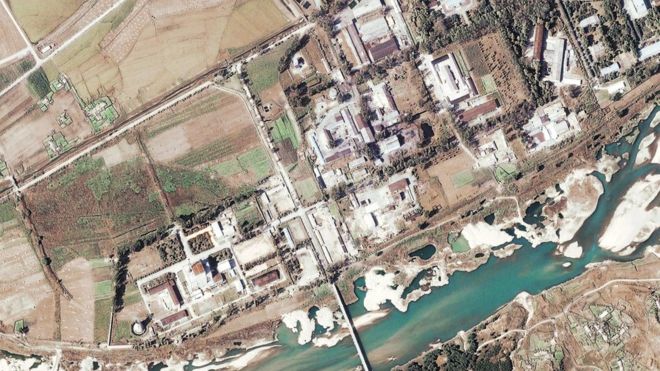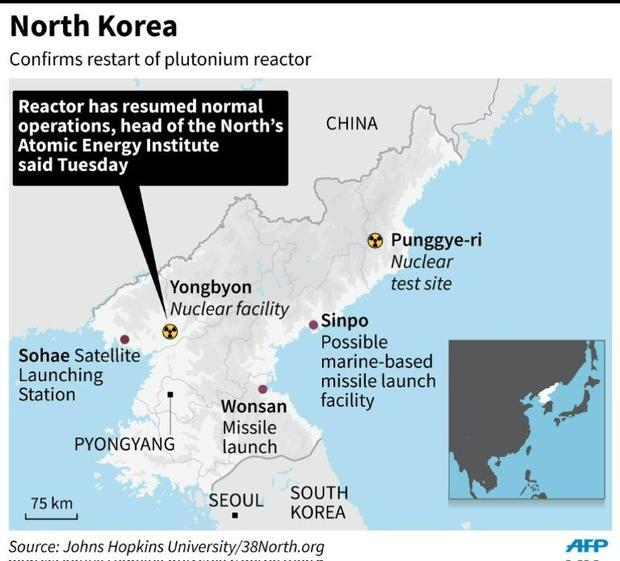Yongbyon open to inspections
November 29, 2018 | Expert Insights

Kim Jong Un is willing to let international inspectors visit the Yongbyon nuclear site, North Korea’s main nuclear facility.
Pyongyang had previously allowed entry to the Nyongbyon site back in 2009, and since then has kept it under a cloud of secrecy.
Background
The political and diplomatic relations between North Korea and the United States have been historically hostile, developing primarily during the Korean War. In recent years relations have been largely defined by North Korea's nuclear program– six tests of nuclear weapons, its development of long-range missiles capable of striking targets thousands of miles away, and its ongoing threats to strike the United States and South Korea with nuclear weapons and conventional forces.
The Yongbyon Nuclear Scientific Research Centre is North Korea's major nuclear facility, operating its first nuclear reactors. It is located in Nyongbyon County in North Pyongan Province, about 100 km north of Pyongyang. The centre produced the fissile material for North Korea's six nuclear weapon tests from 2006 to 2017, and since 2009 is developing indigenous light water reactor nuclear power station technology. Since early 2018, nuclear testing at Yongbyon has ceased and the site has seen hardly any movement in activity.
The US and the UN have placed tough economic penalties on North Korea. Around 90% of its exports are banned including coal, iron ore, seafood and textiles. There are also caps on the amount of oil it can buy. If Kim Jong-un is going to build up his economy as he has promised his people, then he will need the sanctions lifted. The US has underlined that there will be no sanctions relief until "complete denuclearisation".

Analysis
North Korean leader Kim Jong Un is open to inspections at his country’s main nuclear complex located at the Nyongbyon district. This announcement comes exactly one year since the last North Korean missile test.
Kim is willing to let international inspectors visit the Nyongbyon nuclear site, which was lasted inspected in 2009, under Kim Jong Il’s regime. Kim had earlier told South Korean President Moon Jae-in during their September summit that he would be willing to shutter the complex if the U.S. took “corresponding” measures.
President Moon passed the message on to U.S. President Donald Trump when the two met on the side-lines of the United Nations General Assembly in New York later that month. While the proposed shutdown had been previously reported, the offer to allow inspectors at the site had not.
According to international experts, Nyongbyon houses a 5-megawatt reactor, centrifuges, fissile materials such as uranium and plutonium for bombs, and other facilities and equipment.
Asked about reports of North Korean willingness to allow inspectors in and whether there had been new developments, State Department spokeswoman Heather Nauert said that she was “not aware of any of that,” but noted Kim had agreed to inspections in a meeting with U.S. Secretary of State Mike Pompeo recently. It was not clear from her remarks whether Kim had specifically said inspectors could visit all the facilities in the Nyongbyon site.
Trump has repeatedly boasted about what he says are North Korean steps toward denuclearization, hailing the absence of missile or nuclear tests since last year and the return of remains of U.S. service members killed in the 1950-53 Korean War as “incredible progress.”
Pyongyang’s last missile test (Hwasong-15 intercontinental ballistic missile) was on Nov. 28, 2017. Experts believe the missile is capable of striking most, if not all, of the United States.
Trump has faced criticism over his claims, with some saying there is no evidence the North has taken significant steps toward denuclearization, despite the president’s remarks to the contrary.
Counterpoint
South Korean critics have attacked the offer to close the facility as merely for show, pointing to a number of other known and unknown nuclear sites. Some have even claimed that Nyongbyon had been built specifically for the purpose of allowing for its later dismantlement — while maintaining its clandestine sites.
Assessment
Our assessment is that North Korea’s rapidly improving relations with the rest of the world, particularly with South Korea, is a major development in re-integrating the country in the global economy. We believe that Kim Jong Un’s announcement is just one of the many goodwill gestures announced in the aftermath of the Trump-Kim Summit.








Comments